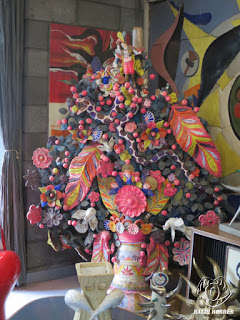 |
| Museum entrance |
Okamoto Taro (1911-1996) was one of the most prominent Japanese artists of the 20th century. He led quite a life, fighting in World War II, studying in Paris, and hobnobbing with the likes of Picasso and Breton. Taro's work featured a kind of primitive abstract style that was widespread at the time, and, just like prolific artists such as Picasso, he created paintings, sculptures, and everyday objects including tables, chairs, and dishes.
 |
| Taro sculpture in front of United Nations University, Shibuya |
To me, one of the most compelling aspects of his work is how accessible and visible it is. I've seen public art by Taro in several spots in Tokyo (including a massive mural inside Shibuya station), and I've had the chance to see his monumental Tower of the Sun, which he created for the 1970 World Expo just outside of Osaka. The grounds make a great day trip if you're in the Kansai area.
Today was my first visit to the
Okamoto Taro Memorial Museum, which is located in Aoyama, Tokyo, just down the road from Omotesando station. The building, where he lived and worked, retains many artifacts from his studio in addition to hosting exhibitions. It's small, but like Taro's work, it's personable. You can get close to the art, and in the case of the garden sculptures, you can walk right up to them as they inhabit an overgrown mini jungle - which is probably just the way Taro intended (and in stark contrast to the well laid out, planned, and often surgically precise gardens found throughout Japan).
First, here are some visiting details:
Address: 6-1-19, Minami-Aoyama, Minato Ku, Tokyo 107-0062
Phone: 03-3406-0801
Map:
Click for Google Map
Nearest train stations: Omotesando, Shibuya
Hours: 10:00-18:00 (final admission 17:30) (Closed Thursdays, except on national holidays. Closed Dec 28- Jan 4)
Now let's head inside.
First Floor
 |
| Museum lobby |
The entrance fee is very reasonable - just 620 yen. The first floor contains a look at Taro's studio and a kind of seating room area containing many objects.
 |
| An eerily lifelike sculpture of Taro greets you. After seeing the Murakami sculpture the other week, I'm beginning to sense a pattern! |
More after the jump:
 |
| Perhaps a study of the university sculpture, or maybe just a similar work. |
Into the studio:
 |
| The studio is roped off, but you get a great look at the space, which has an impressively high ceiling. |
 |
| Taro was fascinated by ancient Jomon pottery from Japan. This piece, presumably by Taro, is sitting in the middle of the studio. |
 |
| A tantalizing look at what's housed on the many shelves! |
Second Floor
 |
| Original Jomon pottery. This 5,000-year-old piece and those in the following image are part of an ongoing exhibition. |
 |
| The second floor also contains a nice selection of Taro's paintings, as well as some sculptures. |
 |
| How awesome would it be if they cast these and made them available as planters!! |
 |
| Wall of Taro |
 |
| Miniature of the Tower the Sun |
 |
| Taro's work wasn't all flowers and sunshine, Some of it is brooding, even downright violent. |
Garden
 |
| This sculpture garden is just in front of the museum. |
 |
| It's packed with artworks, which stand there like strange, yet friendly creatures. |
 |
| Much of the space is truly overgrown, with sculptures peeking out from the foliage! |
 |
| A piece designed to be a planter is...a planter! Amazing that the work, which is surely quite valuable, is used as intended and not fettishized as an "ouvre d'art." |
 |
| Some tropical tree species populate the garden. There are several signs warning of bees. |
 |
| In some ways, nature is reclaiming these creations bit by bit. |
 |
| Hello, friend! |
Goods
 |
| What would a museum be without some goods to take home? There are some nice T-shirts and other things, but the prices are a bit up there. |
 |
| Nice collection of Taro's works, with lots of English explanations. |
 |
| Taro gachapon toys. I see these around from time to time. Kaiyodo made some, if I remember correctly. |
Taro was known for the saying, "Art is an explosion!" To get a sense of what he meant, head over to his home in central Tokyo. And make sure to join us on
our Facebook page to drop a comment and say hello.
Thanks for visiting!


















































No comments:
Post a Comment